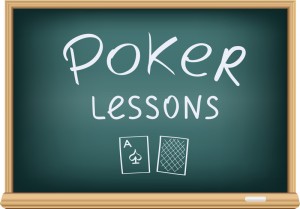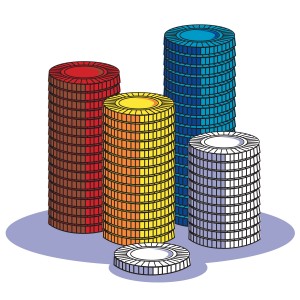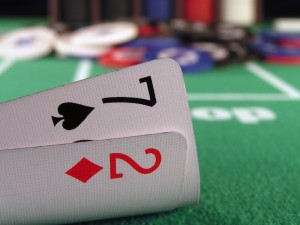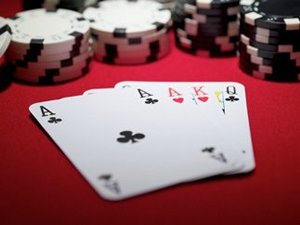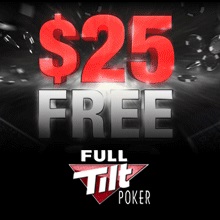One of the most important things to keep in mind while playing an R&A tournament is that the first hour offers a very different style of play than just about any other possible Hold ‘em table. Typically, you’ll have a fair share of opponents playing a loose/super-aggressive style (LAGs). However, it would be a mistake to play these super-LAGs as you typically would in a ring game environment (where you tighten up and hope to trap the maniacs with a monster). During the first hour of an R&A tournament, you’ll have more than your average share of opportunities to double up. But you have to be willing to take those opportunities and you have to be best prepared for them.
First, consider how much you’re willing to spend on this one tournament.
Let’s consider an $11 +$1 R&A tournament where re-buys and add-ons will cost you an additional $11 each. If you’re really only willing to spend the initial buy-in fee of $11 + $1, you really are better off looking for a freeze-out tournament of the same cost. By not considering the possibility of re-buying at least once and then adding on after the first hour, you are most likely going to place yourself into an almost immediate short-stack scenario. You can certainly hope to double through a LAG player, but this isn’t a ring game situation with an endless long-run. You’ve got one hour to compete with these players who are going to coin-flip at a much higher frequency. I recommend committing approximately five times the buy-in amount to any R&A tournament you enter. Hopefully you’ll hit the cards and an early coin-flip (or two) and keep that number lower. This is also the time you should be asking yourself if you are likely to win back the chips you are temporarily “loaning” the table as a better than average player. If you don’t think you’re strong enough to win back the chips you dump during the first hour of coin-flip central, then perhaps you’ll want to begin playing these tournaments with a lower number of re-buys you’ll allow yourself.
Once you sit down, keep a watch for how many players are taking the immediate re-buy. If nobody at your table is taking the re-buy, then you may decide to hold off yourself. If you all start with 1500 tournament chips, it will do you no good to be the only player with double that amount (which is where you’d be if you were the only player at your table to take the initial re-buy). You won’t necessarily be able to use that bigger stack to bully the other players, as you’ll still have plenty of opponents who will call your big bets on a draw or a gamble knowing that they’ll either double through you or re-buy. Rather, sit with the rest of the opponents and try to double up yourself. If you catch the right side of a coin flip, you’ll have taken yourself to the initial re-buy amount while saving yourself $11. Keep in mind, however, that you could also end up in “limbo-land” should you win a small pot (see below).
If, however, you have a handful of players (or more) that takes the initial re-buy, it is in your best interest to do so as well. You must keep yourself in a position to make the absolute most out of any scenario where you stand an opportunity to double up. Take my word for it – you’ll instantly regret having opted not to re-buy when you take your $1500 stack against another player’s $3000 when you are dealt rockets. You will have settled to save $11 to arrive at a $3000 stack level when you could have spent that extra buy-in and arrived at a $6000 stack.
But what if you’re in between those levels and hovering in limbo-land? Most R&A tournaments allow you to re-buy if you are at or below the starting chip level. This is another important factor to keep in mind. Perhaps you were in a situation where you didn’t re-buy due to the fact that nobody else at your table did. You’ve won a few small pots and now find yourself with a stack of $1650. Given the volatile coin flips you often see in these tournaments, you have opponents with anywhere from $750 to $7500. Perhaps you took the initial re-buy but have now blinded down and have lost a few pots, thereby bringing your stack to approximately $2200. You now don’t have the optimal stack against those who have gambled and doubled a few times, but you still have an average stack.
In such situations, I’ll often place very strategic bets pre-flop in order to either steal a few limps or set myself up to control the hand post-flop. If the re-buy threshold is at $1500, and I’m holding $2200, I’ll actually consider the fact that I’ve got $700 to mess around with and plan my bets accordingly. If the big blind is at the $50 amount, I can place a $200 pre-flop bet and look fairly strong. If I don’t win pre-flop, I can still put out a $500 bet on the flop and either take the hand down or fold on the turn to an obvious sign of strength. If I win the hand, I’m well on my way back to the $3000 range. If I need to fold, I’ve taken myself to exactly $1500 and re-buy to that amount anyway. Keep in mind, however, that I certainly try to make this sort of move with a hand that has a decent chance of evolving into a winner. I don’t make this sort of move if I’m holding a monster pre-flop.
If I’m holding a monster pre-flop, I’ll often push it all-in during the re-buy hour. I’ll sometimes use the limp with the hopes of taking an opportunity to re-raise all-in, but I’ll nearly always push it right away with the assumption that at least one opponent will give me the coin flip against my solid hand (AA, KK, QQ, etc.). I’m also not shy about forcing a few coin flip situations myself with any pocket pair or a suited slick. If, however, I’m approaching my upper limit of re-buys I’ve allowed myself for this particular tournament, I’d much rather start the aggression with a monster hand than answer it with a known gamble. R&A tournaments are all about pushing smaller edges with more aggression than is typical and pushing large edges with maximum aggression. Don’t pay too much attention to those chip leaders who are building huge stacks. Those are inflated rankings that are nearly always a result of short term tournament luck. As you play more and more tournaments at the same site, you’ll begin to recognize the consistent chip leaders who are credible well beyond the first hour.
As the first hour comes to an end, pay particular attention to your LAG opponents. Often times, many players will take one or more extreme gambles with the hopes of entering the start of the “real” tournament with a stack that will compete with the chip leaders. In the final five to ten minutes, you’ll see plenty of crazy plays. If you’re hovering in the $3,000 range, try your best to maintain your stack while looking for a solid coin flip opportunity yourself. Ideally, you’ll want to enter such situations with a solid hand that will hold up without improvement. If you’re on the low side of limbo land, try to dump some chips to the maximum re-buy level ($1500 in our examples) while remaining aware of the fact that a pre-flop raise will often get pushed all-in. If you’re not willing to go all-in, then bet yourself to exactly $1500 prior to the flop. I typically wait until I’m down to the $1750-$2000 range before dumping my chips. I’ll also wait to do so until I’m fairly certain the blinds won’t reach me and thereby drain myself down to less than $3000 chips again. If I’m holding $6000 or more during the final minutes of the first hour, I will often coast unless I have AA or KK. Many players with big stacks will actually sit out during this portion of the tournament (be on the lookout for blind stealing opportunities if these players are to your immediate left).
Once all of the tables have completed their final hands of the first hour, you’ll have the opportunity to add-on during the first break. Always add-on. Always. Once you’ve done so, take your well deserved break and prepare yourself for the “real” tournament. Play your solid MTT strategies and hit that final table hard. Keep in mind that many players will not shift gears appropriately once the re-buy period is done. Now you can play these jokers like the MTT LAGs that they truly are by patiently waiting for the best opportunity to trap them into handing over their entire hour-one stack.
If you’re willing to dance around a bit for an hour, R&A tournaments offer an opportunity to add subtly enhanced strategies to your game. Start with a low buy-in R&A event and enjoy the looser/more aggressive play than you typically play during a regular freeze-out MTT. Just don’t let it become a habit and remember to return to your solid long-run game.
Good luck! But remember … it’s better to be good than lucky.
Troy Headrick
AKA: BernardDogs
Submit your review | |

